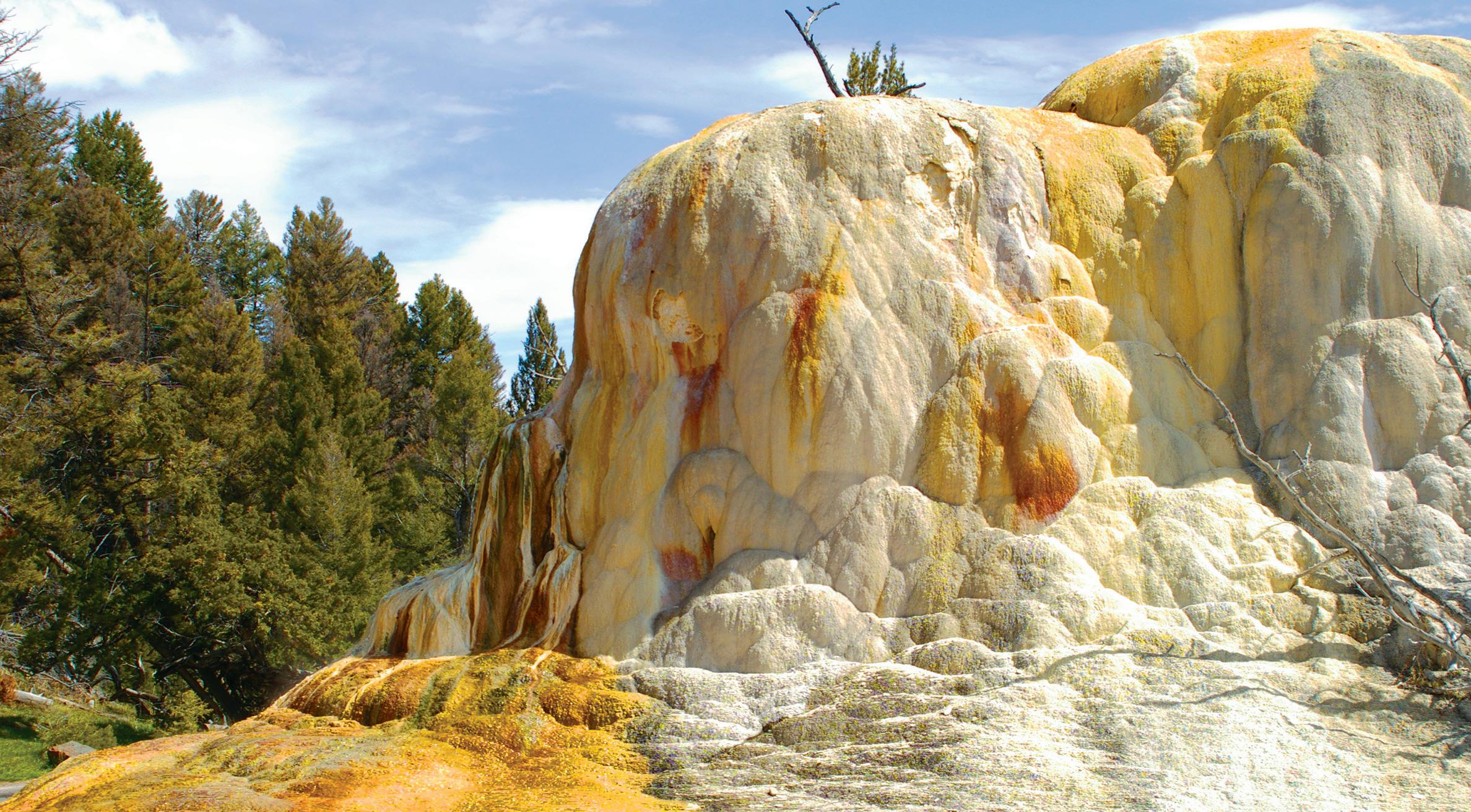
5 minute read
Visiting Yellowstone
By CLAUDIA NEWCORN
It’s 30 degrees outside. Scalding geysers are invisible in their steaming mantles. Snow drizzles among the pines, cloaking bison, elk and mountains in white. Welcome to Yellowstone National Park in the last week of May.
Established in 1872, Yellowstone is our first national park. Home to one of the world’s super volcanoes, one third of the park lies within the last eruption’s massive caldera, including Yellowstone Lake. Over 600,000 years ago, the volcano vaporized an entire mountain range, exploding ash and debris in a footprint that reached all the way to Central Valley.
Anchored by lodging and a Visitor’s Center complex, at 2.2 million acres, it’s so vast, it’s divided into five “countries”: Mammoth, Geyser, Lake, Canyon and Tower-Roosevelt. Each has its own highlights and characteristics. GEO-THERMAL OVERLOAD
With over 10,000 geo-thermal features, Yellowstone boasts the world’s largest concentration of active geysers. Magma is close to the surface – some three to eight miles beneath – and this, combined with water seepage through underground
Stop and listen to the delighted trill of
a mountain bluebird. Feel the grumble of cracks has led to a hyperactive “plumbing system” replete with an impending geyser eruption vibrate geysers, hot springs, mud pots, and fumaroles. Geyser Country is parsed beneath your feet. Be engulfed by tumbling out into Upper, Middle and Lower Basins, with places like Black Sands, Fountain Paint steam that comes from the earth’s Pot and Grand Prismatic Spring. You can literally spend days prowling just geo-thermal heart. Experience Yellowstone. sites. Upper Basin is home to the broadest diversity, including Old Faithful. It’s neither the biggest nor the best, but its frequent and reliable eruptions (every 1.5 hours or so) make it popular. The Basin actually has numerous other geysers that erupt regularly, but the spread between eruptions (8-14 hours, give or take 2+ hours) requires visitors to settle on a convenient bench and enjoy the scenery. The Visitors Center posts estimated eruption times for all geysers, enabling you to plan your walk around the basin’s many trails accordingly. My favorite was Castle Geyser. Its ancient cone erupts for up to an hour in blasts of steam and water reaching over 75 feet. Old Faithful, just a few hundred years old, is a short amble away, and froths 130 feet, lasting 5-8 minutes. Both are an easy walk from the 1904 historic landmark Old Faithful Inn – itself well-worth a visit – and Old Faithful Lodge Cabins. The biggest surprises? No smell. I had expected a pervading
sulfur stink to permeate the park, but except for a few spots, there is little to no odor. Another was the thermophiles – heat-loving bacteria that thrive in the near-boiling waters, and produce a colorful rainbow ranging from acid green to buttercup yellow to rose pink. Minerals render many hot springs shades of turquoise to indigo.
If you want to see bison, this is the place, with the world’s last freeroaming herd. Over 2,000 strong, they often cause “Bison Jams” as they use the main roads to travel about the park, stopping to burnish their horns on well-polished “bison rubs” that mark roadside trees, and forcing cars to wait or follow them at a creeping speed. “People Jams” are also commonplace – cars pulling over or even stopping in the road whenever wildlife is sighted to take photos.
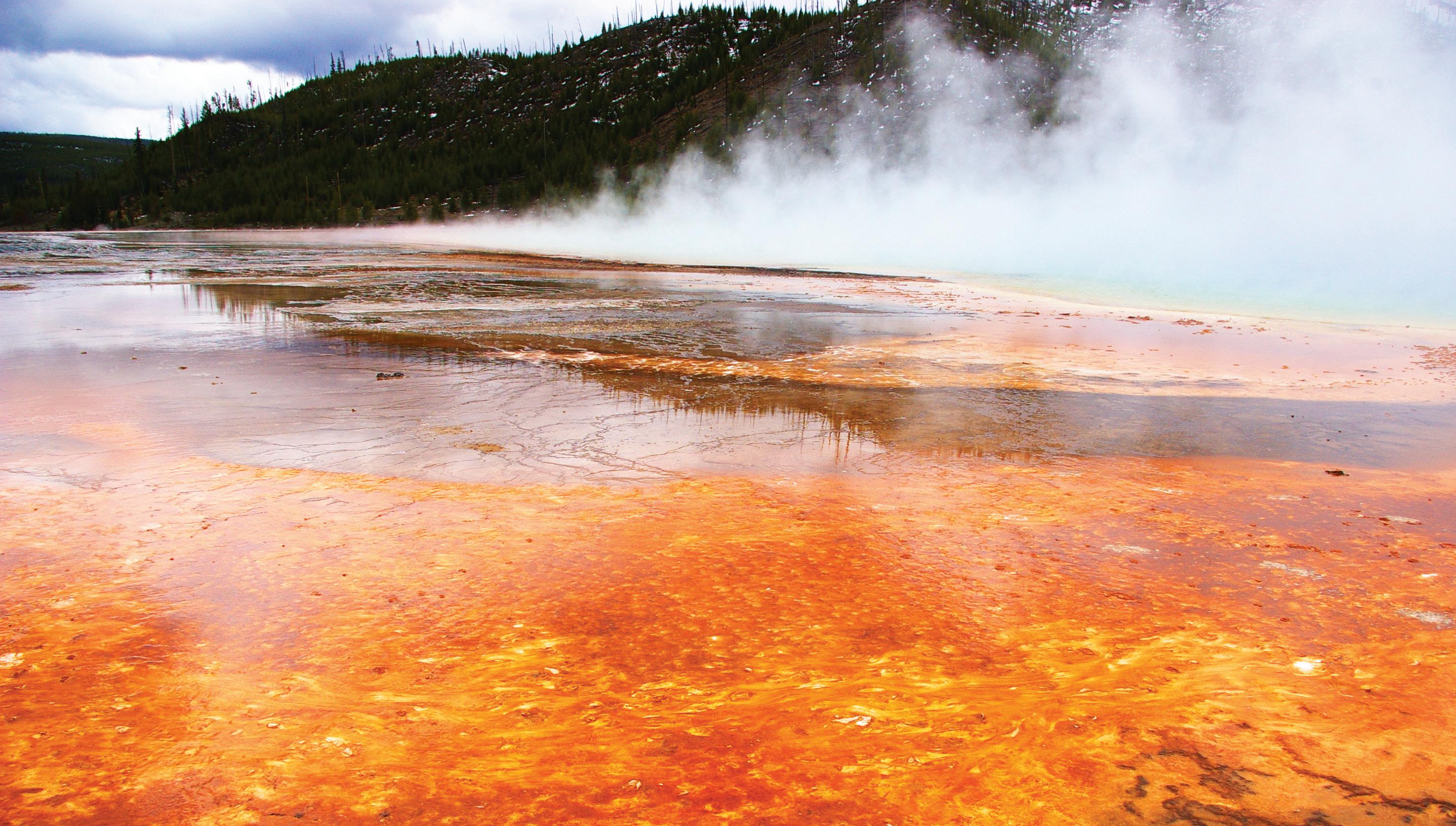
GRAND CANYON, MAMMOTH SPRINGS & MORE
Carved through colorful layers of volcanic rock by the Yellowstone River, the Eastern Grand Canyon and its waterfall is stunning.
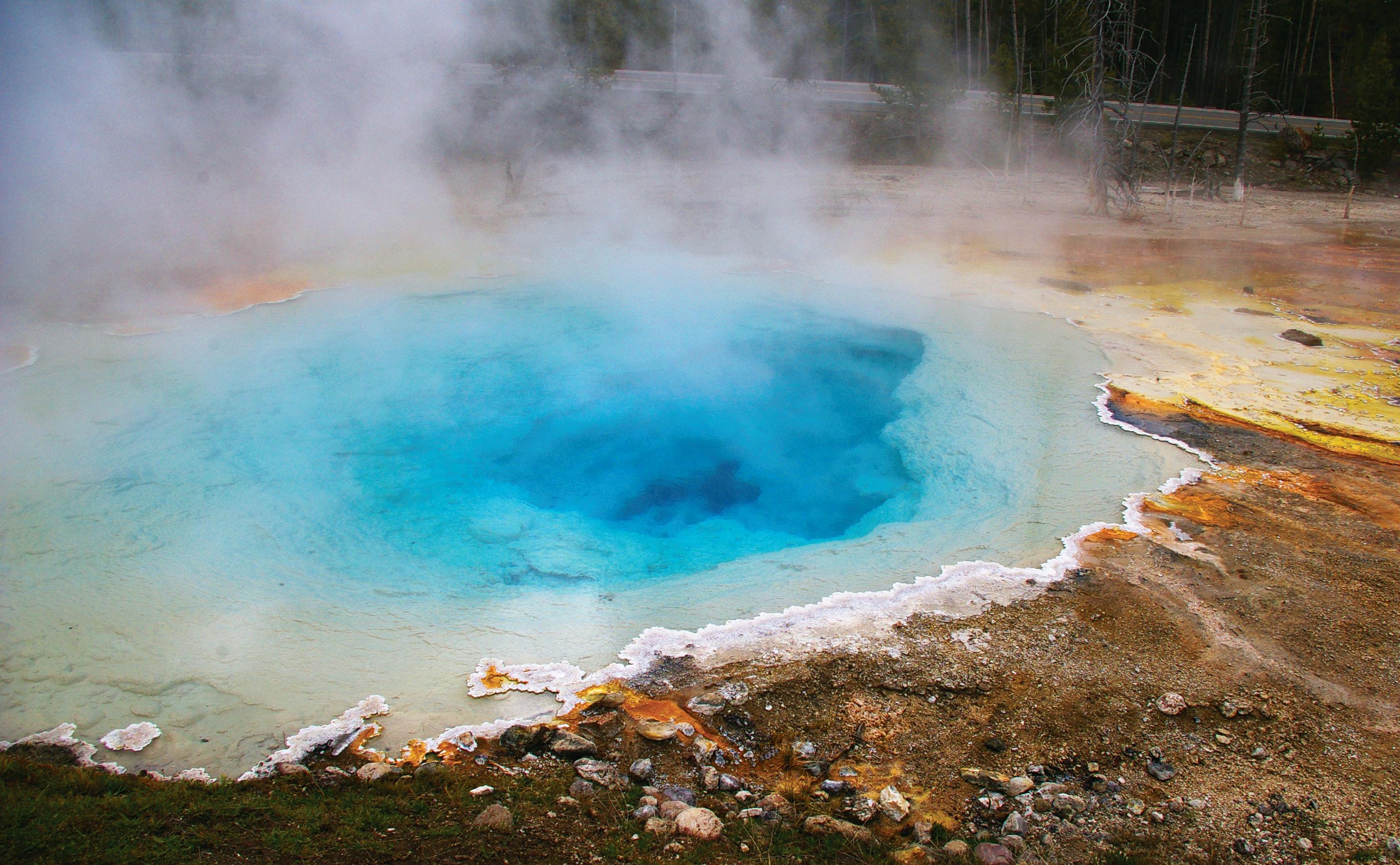

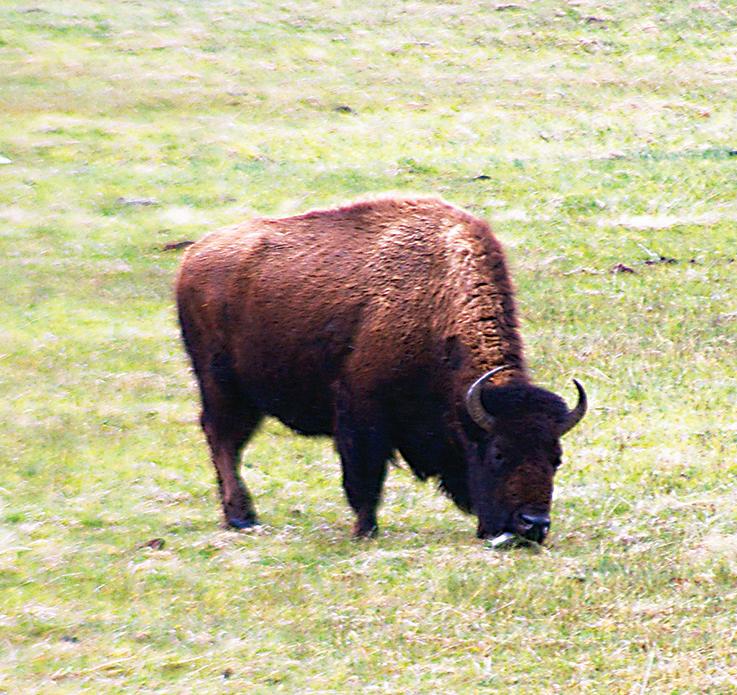
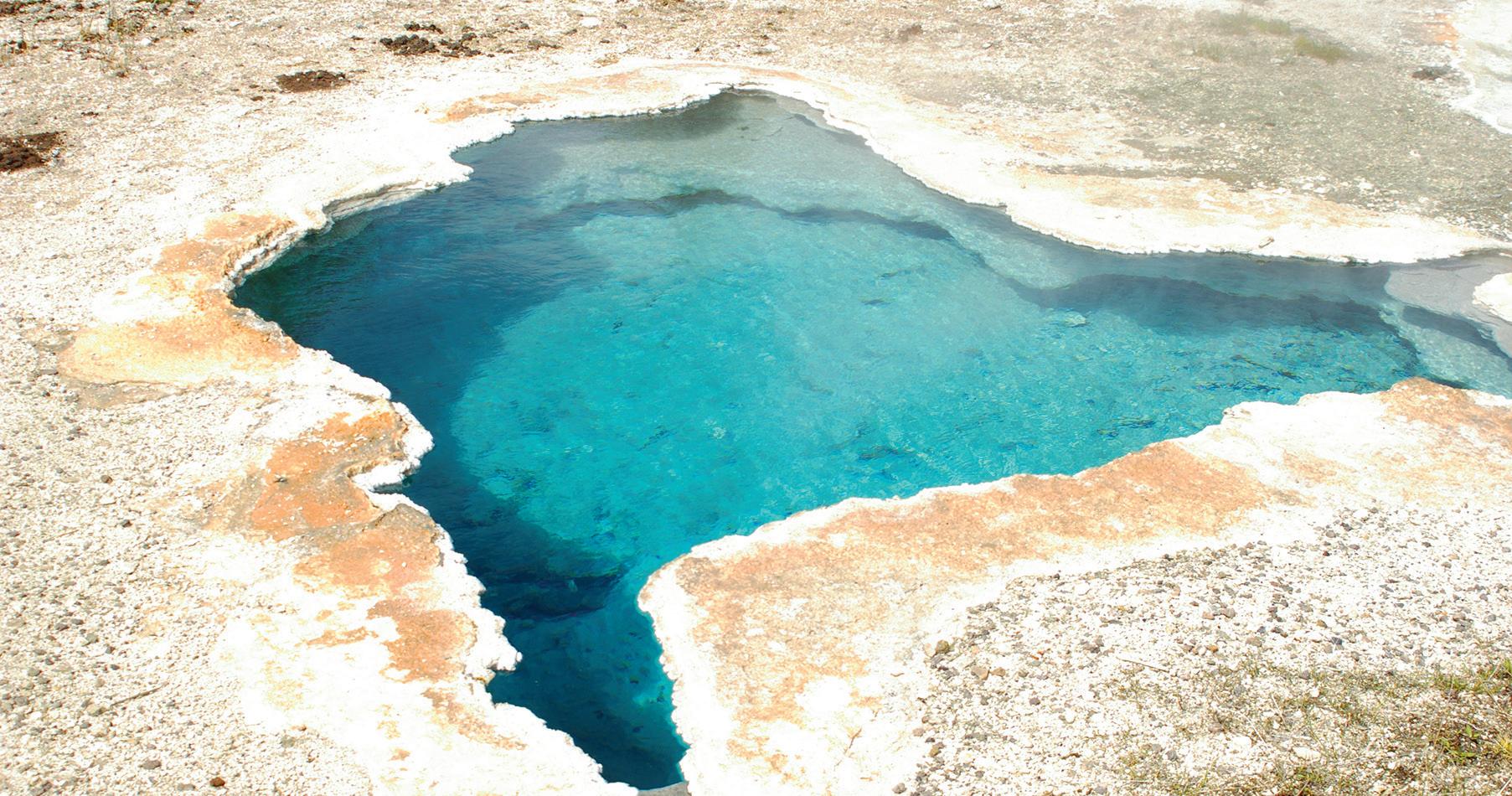

Mostw people enjoy them from convenient paths and overlooks. On the other side of the park, Mammoth Hot Springs, viewed from historic Fort Yellowstone, is a huge ancient stair-stepped series of limestone terraces. Most of it is weathered pale grey stone, with only a scattering of sections offering the colorful images seen on TV. Lower Terrace has the most colorful; Upper Terrace the greatest variety.
Even in late May, the 132-square mile Lake Yellowstone was still frozen, a glorious icy shimmer that reflected the glitter of the Grand Tetons and Absaroka Mountains. On my visit, Tower-Roosevelt Country was still sealed off by snow.
A GRAND VACATION
Mostly on a 7,000-foot volcanic plateau, Yellowstone ranges between 5,300-11,400-foot elevation and spans the Continental Divide. There are literally two seasons: winter and summer. Most of the park is only open from mid-May to late September. Many facilities are closed until mid-June due to snow. This condensed season means it’s best to make reservations well in advance.
Unless you just want to skim the highlights, you can’t really do all of Yellowstone in one trip without staying there for a week. With so much to see, each “country” can easily take two or more days. Plan on dressing in layers (snow falls in July), sunscreen, brimmed hats, and good walking shoes. Save money by bringing a large cooler with beverages and snacks. Cell phone coverage can be spotty – which makes it a wonderful way to slow down and disconnect from the world for a few days.
The park is exceptionally car-friendly, designed in an era when Model Ts chugged around, following a figure-8 road that is known as the Grand Loop.
Countless pullouts, roadside trails and overlooks invite motorists to stop and experience their surroundings. Even those with limited mobility are able to enjoy the park, taking advantage of boardwalks and access ramps.
Over 950 miles of hiking trails invite exploration deeper into the interior, and biking is also an option. Photography is awesome, yet can be challenging because of unpredictable weather and steam.
Promptly wipe off any steam that touches your lens; the mineral content can damage them.
Stop and listen to the delighted trill of a mountain bluebird. Feel the grumble of an impending geyser eruption vibrate beneath your feet. Be engulfed by tumbling steam that comes from the earth’s heart. Experience Yellowstone. ●
For the most current information and park conditions, visit www.nps.gov/yell/ index.htm.










